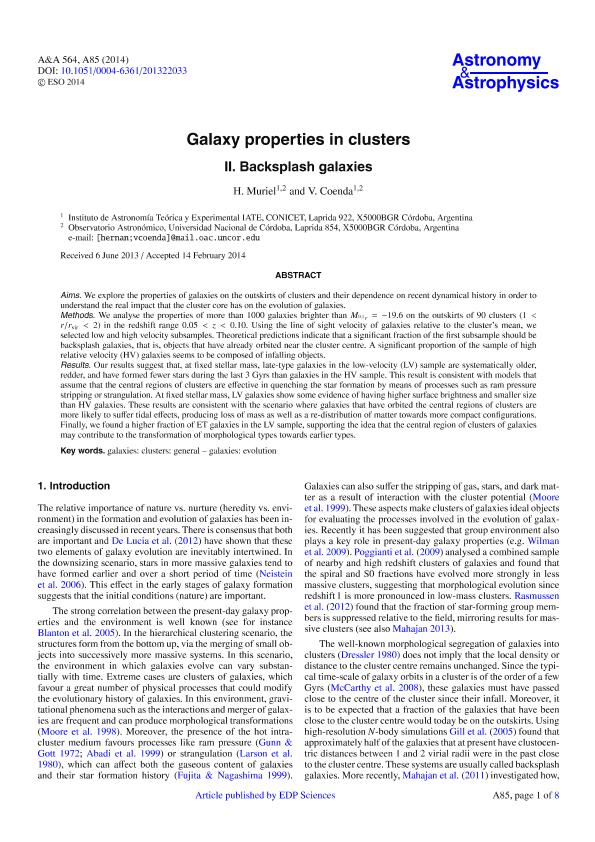Mostrar el registro sencillo del ítem
dc.contributor.author
Muriel, Hernan

dc.contributor.author
Coenda, Valeria

dc.date.available
2018-01-04T21:18:19Z
dc.date.issued
2014-04
dc.identifier.citation
Coenda, Valeria; Muriel, Hernan; Galaxy properties in clusters: II. Backsplash galaxies
; EDP Sciences; Astronomy and Astrophysics; 564; 4-2014; 1-8; A85
dc.identifier.issn
0004-6361
dc.identifier.uri
http://hdl.handle.net/11336/32374
dc.description.abstract
Aims: We explore the properties of galaxies on the outskirts of clusters and their dependence on recent dynamical history in order to understand the real impact that the cluster core has on the evolution of galaxies. Methods: We analyse the properties of more than 1000 galaxies brighter than M0.1r = − 19.6 on the outskirts of 90 clusters (1 < r/rvir < 2) in the redshift range 0.05 < z < 0.10. Using the line of sight velocity of galaxies relative to the cluster’s mean, we selected low and high velocity subsamples. Theoretical predictions indicate that a significant fraction of the first subsample should be backsplash galaxies, that is, objects that have already orbited near the cluster centre. A significant proportion of the sample of high relative velocity (HV) galaxies seems to be composed of infalling objects. Results: Our results suggest that, at fixed stellar mass, late-type galaxies in the low-velocity (LV) sample are systematically older, redder, and have formed fewer stars during the last 3 Gyrs than galaxies in the HV sample. This result is consistent with models that assume that the central regions of clusters are effective in quenching the star formation by means of processes such as ram pressure stripping or strangulation. At fixed stellar mass, LV galaxies show some evidence of having higher surface brightness and smaller size than HV galaxies. These results are consistent with the scenario where galaxies that have orbited the central regions of clusters are more likely to suffer tidal effects, producing loss of mass as well as a re-distribution of matter towards more compact configurations. Finally, we found a higher fraction of ET galaxies in the LV sample, supporting the idea that the central region of clusters of galaxies may contribute to the transformation of morphological types towards earlier types.
dc.format
application/pdf
dc.language.iso
eng
dc.publisher
EDP Sciences

dc.rights
info:eu-repo/semantics/openAccess
dc.rights.uri
https://creativecommons.org/licenses/by-nc-sa/2.5/ar/
dc.subject
Galaxies: Clusters: General
dc.subject
Galaxies: Evolution
dc.subject.classification
Astronomía

dc.subject.classification
Ciencias Físicas

dc.subject.classification
CIENCIAS NATURALES Y EXACTAS

dc.title
Galaxy properties in clusters: II. Backsplash galaxies
dc.type
info:eu-repo/semantics/article
dc.type
info:ar-repo/semantics/artículo
dc.type
info:eu-repo/semantics/publishedVersion
dc.date.updated
2018-01-03T20:10:50Z
dc.journal.volume
564
dc.journal.pagination
1-8; A85
dc.journal.pais
Francia

dc.description.fil
Fil: Muriel, Hernan. Consejo Nacional de Investigaciones Científicas y Técnicas. Centro Científico Tecnológico Conicet - Córdoba. Instituto de Astronomia Teórica y Experimental. Universidad Nacional de Córdoba. Observatorio Astronómico de Córdoba. Instituto de Astronomia Teórica y Experimental; Argentina
dc.description.fil
Fil: Coenda, Valeria. Consejo Nacional de Investigaciones Científicas y Técnicas. Centro Científico Tecnológico Conicet - Córdoba. Instituto de Astronomia Teórica y Experimental. Universidad Nacional de Córdoba. Observatorio Astronómico de Córdoba. Instituto de Astronomia Teórica y Experimental; Argentina
dc.journal.title
Astronomy and Astrophysics

dc.relation.alternativeid
info:eu-repo/semantics/altIdentifier/doi/http://dx.doi.org/10.1051/0004-6361/201322033
dc.relation.alternativeid
info:eu-repo/semantics/altIdentifier/url/https://www.aanda.org/articles/aa/abs/2014/04/aa22033-13/aa22033-13.html
Archivos asociados
